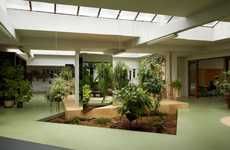
The Orange House Allows Children to Connect with the Environment
Jamie Danielle Munro — July 28, 2014 — Art & Design
References: www5a.biglobe.ne.jp & designboom
The firm Norisada Maeda Atelier has designed the Orange House, intended to make children interact with their environment more instead of simply accepting everything in its current form.
Basically the children are forced to put more effort into moving around the space, instead of simply moving through. There are certain sections of the house where children have a choice for getting from one spot to the next. For example kids have the opportunity to either climb up a smooth, sloping surface to get to the next level or take the stairs. These subtle changes stimulate the children's brains and make them exercise problem solving skills. Another interesting feature is the glass floor between levels, so that kids can look down and see their classmates playing around and having fun too.
Photo Credits: designboom, www5a.biglobe.ne.jp
Basically the children are forced to put more effort into moving around the space, instead of simply moving through. There are certain sections of the house where children have a choice for getting from one spot to the next. For example kids have the opportunity to either climb up a smooth, sloping surface to get to the next level or take the stairs. These subtle changes stimulate the children's brains and make them exercise problem solving skills. Another interesting feature is the glass floor between levels, so that kids can look down and see their classmates playing around and having fun too.
Photo Credits: designboom, www5a.biglobe.ne.jp
Trend Themes
1. Interactive-design - Designing spaces that encourage interaction and engagement can enhance problem-solving skills in children.
2. Spatial-choice - Creating spaces with multiple pathways and options for movement can stimulate children's brains and decision-making abilities.
3. Transparency-experience - Incorporating glass floors and windows can provide children with visual connections to their environment, promoting social interaction and a sense of belonging.
Industry Implications
1. Architecture - Architects can leverage interactive design principles to create innovative and engaging spaces for children's play and learning.
2. Education - Educational institutions can adopt spatial-choice designs to foster problem-solving and critical thinking skills in children.
3. Childcare - Childcare centers can explore transparency experiences in their design to promote social interaction and a sense of community among children.
0.8
Score
Popularity
Activity
Freshness























